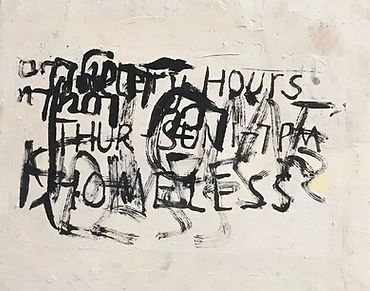
复 写 本
2023
创作脉络
在文本研究中,“重写本”(palimpsest)原指将卷轴或羊皮纸上的文字刮除或洗净后,重新书写的文献。最初,这一做法出于节省材料的实际需要。随着时间推移,这一术语被广泛引用至建筑学、考古学与地貌学等领域,用以描述某种被反复利用、不断改写的状态。重写本往往隐含着历史层层覆盖、彼此注解的痕迹。
由于我对存在主义哲学的痴迷,我的过往创作几乎无一例外地是一种在时间中不断“重写”的过程。并非“擦除后的复写”,而是“有意识的不擦除”——一种不断叠写的实践。即便是减除法也是为了增添新层。层叠带来的肌理,突破视觉美感的单一维度,转化为更复杂的生死伴随的存在主义物理证明。
但在此页面中,重写本回到了写的本意,文字成为这个系列的主角。因为我发现,文字不同于其他视觉因素,文字的“可读性”被削弱的同时,其“可感性”反而增强,仿佛文字自身拥有一种既不完全依赖于语意完整、也不完全依赖视觉完整的能量场,即便无法被解读,依然保持其感召力。又如同那些被时间掩埋的历史碎片,越是模糊,越激发探寻的冲动。
作为一位自幼接受传统书法训练的东方艺术家,我不仅“复写”,更关注“写”本身。因为这一动作早已嵌入我的身体经验,成为一种由手至心的触觉惯性; 作为一个异质文化新入者,我的汉文字基因常常不受控制地挣出来,企图在拉丁语境中获得一席之地;
在这个“重写本”系列中,我将佛经、古琴琴谱、流浪者诗等文本折叠入抽象表现,这里“写”帮助图像文本的生成,帮助文化记忆的再现,并实施对语言结构、身体动作与视觉系统的持续追问。
在视觉呈现上,这一系列融合了中国书法中“隐”与“显”的流动逻辑,并融入极简主义的秩序感、材料肌理的物质性、拼贴装置的构成方式以及抽象表现的自由能量。这些异质元素彼此碰撞又共生,指向一种“写”与“重写”、消解与生成并存的文化状态。(罗一)

复写本-1
布面油画, 48*48"
2023

复写本-2
布面油画,48*48",
2023

半部金刚经
综合材料,60*84英寸
2023

古琴-1
综合材料, 60*72",
2023

古琴-2
综合材料,60*72",
2023

古琴-3
综合材料,60*72",
2023

心经-1
综合材料,60*72",
2023

心经-2
综合材料, 60*72",
2023,
收藏

心经-3
综合材料 60*72",
2023

陋室铭
布面油画, 60*72",
2023,
收藏
评析
在“重写”的动作中,罗一不是在回溯历史,而是在生成一种新的文化能量场。
与其说《重写本》系列是对文献概念中“palimpsest”的视觉挪用,不如说它是一种写作性的绘画实践:它将“写”从语义系统中解放出来,赋予其身体性与感官性。正是在这场写与再写、显与隐的持续拉锯中,文字脱离了承载意义的角色,成为文化图像、精神肌理乃至记忆构造的活性单位。
罗一的文字并不总是可读,但它们始终“可感”。这些来自佛经、古琴、诗歌与历史边缘文本的片段,在一层又一层的多媒介肌理中被叠加、遮蔽、重现、颤动——宛如那些被历史沉积、又在梦中浮现的文化碎片。此种视觉语言,不再依赖图像的完整叙事,而是诉诸一种近乎考古学般的观看方式,迫使观者“探入其下”。
在这一过程中,“写”不仅是动作,更是一个结构:它是对文化根基的探询,是汉字与拉丁体系之间的撞击,是身体训练的残影与语义系统边界的抵抗。作品中那种不断叠压的逻辑,与其说是层层覆盖的结果,不如说是各层意识、时间与文明在此交汇的痕迹。
罗一用绘画提出了一个高度复杂的问题:在跨文化、跨语言、跨身体的多重现实中,文字还能承载什么?又如何在无法言说中继续召唤?
这不是在“写”某个确定的文本,而是在绘制一个多重文本的共时剧场。



